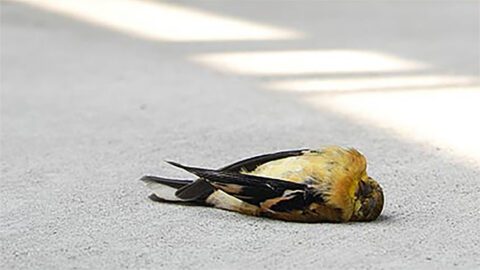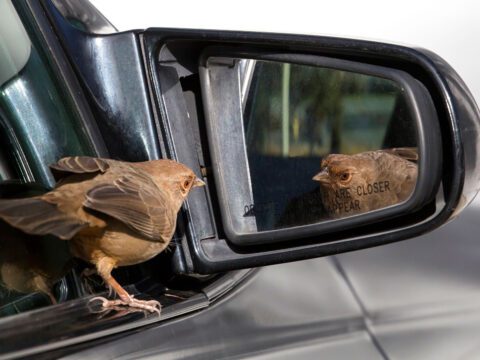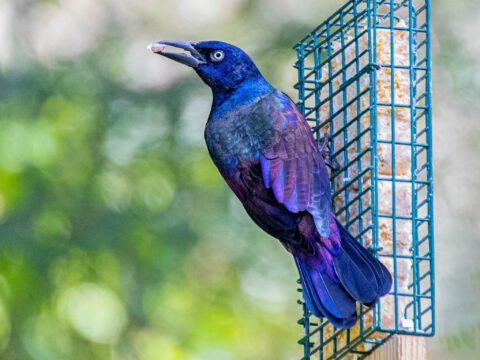How to See a Sound That’s a Half-Second Long
By Lewis Grove and Mike Powers, Cornell Lab researchers
April 13, 2009Spring migration means early mornings and great bird watching. But we think some of the most exciting birding happens all night long, as migrants fly northward over our heads. By now, even here in Ithaca, New York, we’re hearing Hermit Thrushes, Brown Creepers, and White-throated Sparrows passing over Sapsucker Woods. You can step outside and hear night migrants, too – but what exactly should you listen for?
Even the most gifted songsters save their breath while they’re flying. Flight calls are simple and very short: only about a half-second long at most. But they still vary in length, pitch, and quality. Some rise in pitch; others descend. Some are buzzy and others are pure-toned. By noting these characteristics you can determine which species are flying overhead. All you need is to be able to hear enough detail among the tsips, tseeps, zeeps, and sips.
One way to get a better listen is to point a microphone at the night sky and record the calls, then slow them down and analyze them using special software. We use a program developed here at the Lab called Raven (a free version is available for anyone to download.) What we get is a graph called a spectrogram that lets us “see” the sound.
In addition to letting us get much-needed sleep, there is a practical reason for this: We can see far more detail in a spectrogram than our ears could ever detect on their own. In the spectrogram at the top of the post, what you’re seeing in yellow-green are flight calls recorded over about six seconds one fall night. It’s easy to see eight calls – and if you turn your sound up and click play, you’ll hear them as a marker moves across the graph.
You can pick out details on the graph that you might not hear: higher lines on the graph correspond to higher-pitched sounds, and brighter colors mean louder sounds. Taking just the first two calls as an example, you can see how the first one is more squiggly and S-shaped than the second one, which is more comma-shaped. And in fact, those are two different birds: a Veery and a Swainson’s Thrush that were flying over the microphone at the same time.
Now look at the rest of the graph: you can tell that the Veery called five more times and the Swainson’s Thrush called one more time. (There’s also an extremely faint call at about the 2-second mark that’s probably a Gray-cheeked Thrush. It’s hard to hear, but you can see the faint blue trace on the graph.)
The display allows us to measure the sound’s length, frequency, and even loudness (power), as well as more subtle characteristics like modulation and intonation. Measure the call along the horizontal axis to determine the duration, keeping in mind they are typically measured in milliseconds (one millisecond is equal to 1/1000 of a second).
The vertical axis tells you the frequency or pitch, measured in kilohertz (kHz). The highest calls come from the small-bodied warblers and sparrows, and are typically between 6 and 10 kHz. The lowest calls, given by the larger-bodied cuckoos and thrushes, are found between 1 and 6 kHz. The power of the sound, measured in decibels (dB), can be determined by the intensity on the screen.
Taking all of that into account, we can now say that the Veery and Swainson’s Thrush calls are both about 150ms long (much less than a half-second, as it turns out). The Veery call is slightly higher pitched, at 2.8 to 3.4 kHz, while the Swainson’s call lies between 2.3 and 3.2 kHz. The strongest parts of each call measure 90 dB. These are measurements we never could have hoped to gather with just our ears.
Read more about spectrograms – and listen to examples – at the Lab’s Bioacoustics Research Program website.
We hope you’ll listen to the night skies in your area for the flood of migrant songbirds returning to their breeding grounds. Sometime in the coming week would be a great time to give it a try. Then return here to tell us about your outdoor adventures. Even if you can’t identify the calls, have you heard any birds flying over your house at night?
The recording is from September 20, 2007, Airglow Observatory, Jennerstown, Pennsylvania, courtesy of Powdermill Avian Research Center.

All About Birds
is a free resource
Available for everyone,
funded by donors like you
American Kestrel by Blair Dudeck / Macaulay Library




